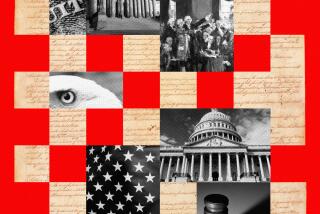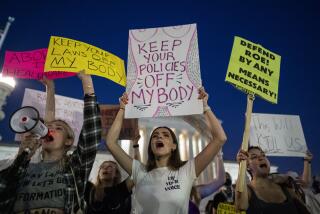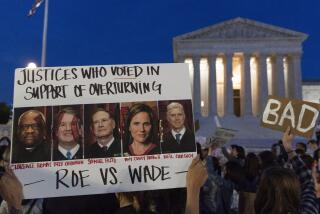Constitution’s Bill of Rights Approaches 200th Anniversary in Top Form : Liberty: The first 10 amendments assured the document’s ratification. States wanted protection from an all-powerful federal government.
- Share via
WASHINGTON — It was added to the Constitution as a political payoff, and played virtually no role in American life for more than a century. But on the verge of its 200th anniversary, the Bill of Rights stands today as a cornerstone of our free society.
Even as people continue to argue over the nuances of its meaning and purpose, the Bill of Rights-- the Constitution’s first 10 amendments--is celebrated as the document that defines America as a nation of individuals.
The Declaration of Independence gave birth to a nation and the Constitution provided an inspired plan of how that nation would govern itself as a representative system. The first 10 amendments, limiting government powers, captured the essence of what America was to become.
There were defects, such as the silent endorsement of slavery and women’s second-class status. But the amendments promised the freedoms of speech, press and religion, pledged protection against arbitrary police behavior and gave voice to the notion of fundamental fairness.
When ratified Dec. 15, 1791, the Bill of Rights fulfilled a political promise its principal author, James Madison, and others made in 1787 to assure states’ acceptance of the Constitution.
Many distrusted the central government and wanted the Constitution, that government’s basic charter, to include a declaration of rights and governmental limits.
“Today we sometimes think that we are entitled to free speech because the First Amendment gives it to us,” said Ira Glasser, executive director of the American Civil Liberties Union, in his book “Visions of Liberty.”
“That is not how the original citizens saw it,” Glasser wrote. “They believed they were entitled as human beings to free speech, and they invented the First Amendment in order to protect it. The entire Bill of Rights was created to protect rights the original citizens believed were fundamentally and naturally theirs.”
The 10 amendments, like any laws, are not self-enforcing. For more than 100 years their impact was minimal.
“Significant protection of individual rights really did not come until judicial interpretations in this century,” said M. David Gelfand, a Tulane University law professor. “Those rulings are what made the Bill of Rights a cornerstone of our free society.”
When ratified, the document served only as a check on the power of Congress. It was not applied to state and local governments until a series of Supreme Court rulings within the last 65 years. The decisions interpreted due-process language in the post-Civil War 14th Amendment to impose certain Bill of Rights obligations on state and local governments. They sparked what historians call the nation’s “rights revolution.”
“It was in the states where most rights were being violated, and the Supreme Court never struck down any state practice until this century,” said William Leuchtenburg, a history professor at the University of North Carolina.
“There was a rebirth for the Bill of Rights with the 14th Amendment and that subsequent history,” he said.
That rebirth, said Alan Slobodin, president of the conservative Washington Legal Foundation, “made the Bill of Rights that which has defined America as a country of individuals. It provided the lexicon of political dialogue in this country.”
The First Amendment’s 45 words contain a vision of the new America as a nation of religious freedom, as one where people, informed by a free press, could speak their minds and complain to their government without fear of reprisal.
Hundreds of court decisions have not resolved the ambiguities of its grand generalities, and the First Amendment remains at the center of frequent litigation.
A source of repeated controversy is the inherent tension between the amendment’s forbidding “an establishment of religion” by government and its ban on government “prohibiting the free exercise” of religious beliefs.
Do city officials establish a religion by placing a Christmas Nativity scene on the steps of City Hall? Variations of that question finding their way into court have become a Christmas tradition of its own.
The Second Amendment, protecting “the right of the people to keep and bear arms” has generated few court cases, although controversy over criminal uses of firearms has made it a political hot potato.
In the Third Amendment, Madison and the Congress miscalculated the need to protect Americans from being forced to house soldiers. That perceived danger never materialized.
The Fourth Amendment reflected colonists’ aversion to unlawful entries into their homes by agents of the king. The amendment adheres to the ancient English maxim, “Every man’s house is his castle,” but its protection from unreasonable searches gradually was extended beyond the home.
That protection reached its zenith in 1967, when the Supreme Court declared that the amendment “protects people, not places.”
Eventually, the notion of privacy--a word that appears nowhere in the Constitution or its 26 amendments--emerged from judicial discussions of the Fourth Amendment. With it came the idea that our most cherished armor against governmental domination is “the right to be let alone.”
The right of privacy was the basis of the court’s landmark 1973 decision voiding state laws against abortion.
The Fifth Amendment is a grab bag of enormously important protections--against being tried twice for the same crime, against forced self-incrimination and against losing private property for some governmental use without “just compensation.”
But perhaps the amendment’s greatest contribution to the fabric of this nation is its promise of due process.
“These words gave voice to basic principles of fairness,” said Rodney Smolla, director of the Institute of Bill of Rights Law at the College of William and Mary.
The next three amendments spell out how people should be treated in court.
The Sixth Amendment promises speedy, public and fair criminal trials.
The Seventh Amendment provides for jury trials in most civil cases.
The Eighth bans excessive bail for people accused of crimes and prohibits cruel and unusual punishment for those convicted.
Madison and other Federalists originally opposed including a declaration of rights in the Constitution because of the impossibility of making it all-inclusive.
Later, state leaders submitted to Madison 124 proposed amendments. Of the 10 ultimately approved, the Ninth states that spelling out certain rights does not mean people do not have other rights as well.
The 10th Amendment, as explained by the Supreme Court 60 years ago, “was intended to confirm the understanding . . . that powers not granted to the United States were reserved to the states or to the people.”
From it the states have derived their separate police and taxing powers, as well as primary control of public education.
It was not immediately clear who was to be the final arbiter of the words contained in the Constitution and its amendments. Madison, though not a lawyer, made a remarkably accurate prediction when, in 1789, he introduced to Congress the Bill of Rights he had fashioned with the help of George Mason, a fellow Virginian.
“Independent tribunals of justice will consider themselves, in a peculiar manner, to be the guardians of these rights,” Madison said.
Fourteen years later, in a case called Marbury vs. Madison, the Supreme Court assumed its role as final arbiter and established its judicial authority by striking down as unconstitutional a law Congress had enacted.
“The majority from time to time takes steps that infringe on the rights of those who can’t outvote them,” the ACLU’s Glasser said in an interview. “An independent judiciary weighing such actions against a set of substantive limits has held us together. Without it, I think we would have been a country in which our many minorities were guests in the home of the majority.”
Roger Conner, executive director of the American Alliance for Rights and Responsibilities, said the Bill of Rights, together with the Constitution to which it was attached, “represents an argument for balance between the needs we have as individuals and the needs we have as members of communities.”
But it is dangerous to consider the Bill of Rights “a device purely for expanding the zone of individual autonomy,” he said.
“There is agreement on its core meaning, but not on the degree to which the rights set forth are purely individual and absolute,” Conner said. “Are these rights the social contract or just part of the social contract? That’s a basic question.”
It is a question that has appeared and continues to appear in myriad forms, in countless legal disputes.
“The American people ought to be paying homage not to the 18th-Century figures in powdered wigs but to 20th-Century men who breathed life into the Bill of Rights,” Leuchtenburg said. “Not to Thomas Jefferson, but to (Supreme Court Justices) Charles Evans Hughes and Harlan Fiske Stone, to Hugo Black and Earl Warren and Bill Brennan.”
Opinion polls suggest that the Bill of Rights would not be popularly supported if it were up for ratification today, a prospect that troubles some scholars.
They point to a warning sounded by the famous jurist Learned Hand: “Liberty lies in the hearts of men and women. When it dies there, no constitution, no law, no court can save it.”
More to Read
Sign up for Essential California
The most important California stories and recommendations in your inbox every morning.
You may occasionally receive promotional content from the Los Angeles Times.










